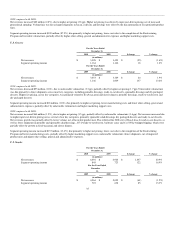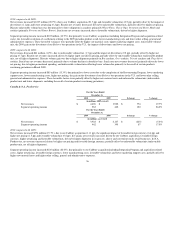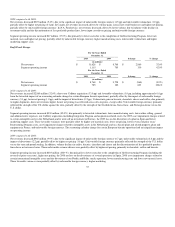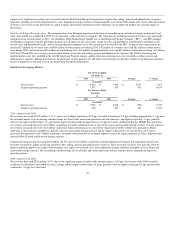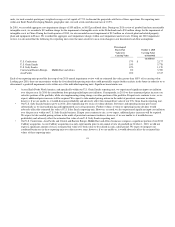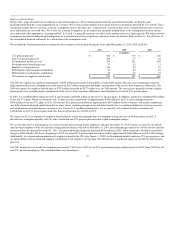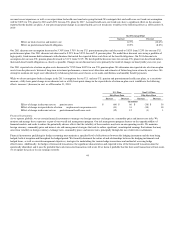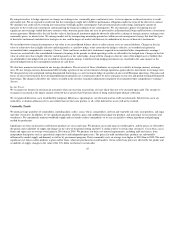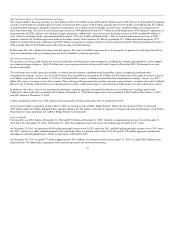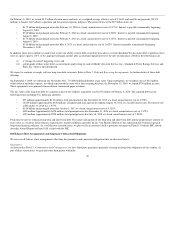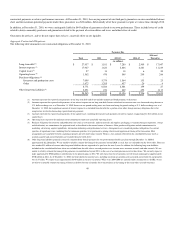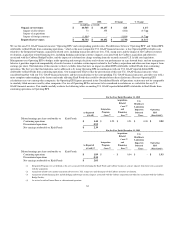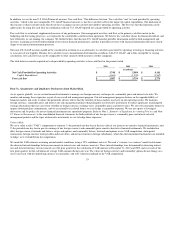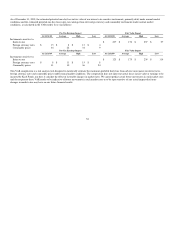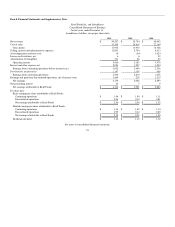Kraft 2010 Annual Report Download - page 48
Download and view the complete annual report
Please find page 48 of the 2010 Kraft annual report below. You can navigate through the pages in the report by either clicking on the pages listed below, or by using the keyword search tool below to find specific information within the annual report.
By using derivatives to hedge exposures to changes in exchange rates, commodity prices and interest rates, we have exposure on these derivatives to credit
and market risk. We are exposed to credit risk that the counterparty might fail to fulfill its performance obligations under the terms of the derivative contract.
We minimize our credit risk by entering into transactions with high quality counterparties with investment grade credit ratings, limiting the amount of
exposure we have with each counterparty and monitoring the financial condition of our counterparties. We also maintain a policy of requiring that all
significant, non-exchange traded derivative contracts with a duration greater than one year be governed by an International Swaps and Derivatives Association
master agreement. Market risk is the risk that the value of the financial instrument might be adversely affected by a change in foreign currency exchange rates,
commodity prices, or interest rates. We manage market risk by incorporating monitoring parameters within our risk management strategy that limit the types
of derivative instruments and derivative strategies we use, and the degree of market risk that may be undertaken by the use of derivative instruments.
We record derivative financial instruments at fair value in our consolidated balance sheets as either current assets or current liabilities. Changes in the fair
value of a derivative that is highly effective and designated as a cash flow hedge, to the extent that the hedge is effective, are recorded each period in
accumulated other comprehensive earnings / (losses). Gains and losses on derivative instruments reported in accumulated other comprehensive earnings /
(losses) are reclassified to the consolidated statement of earnings in the periods in which operating results are affected by the hedged item. Changes in the fair
value of a derivative that is highly effective and designated as a fair value hedge, along with the changes in the fair value of the hedged asset or liability that
are attributable to the hedged risk, are recorded in current period earnings. Cash flows from hedging instruments are classified in the same manner as the
affected hedged item in the consolidated statements of cash flows.
We also have numerous investments in our foreign subsidiaries. The net assets of these subsidiaries are exposed to volatility in foreign currency exchange
rates. We use foreign-currency-denominated debt to hedge a portion of our net investment in foreign operations against adverse movements in exchange rates.
We designated our euro and pound sterling denominated borrowings as a net investment hedge of a portion of our overall European operations. The gains and
losses on our net investment in these designated European operations are economically offset by losses and gains on our euro and pound sterling denominated
borrowings. The change in the debt's fair value is recorded in the currency translation adjustment component of accumulated other comprehensive earnings /
(losses).
Income Taxes:
We recognize tax benefits in our financial statements when our uncertain tax positions are more likely than not to be sustained upon audit. The amount we
recognize is measured as the largest amount of benefit that is greater than 50 percent likely of being realized upon ultimate settlement.
We recognize deferred tax assets for deductible temporary differences, operating loss carryforwards and tax credit carryforwards. Deferred tax assets are
reduced by a valuation allowance if it is more likely than not that some portion, or all, of the deferred tax assets will not be realized.
Commodity Trends
We purchase large quantities of commodities, including dairy, coffee, cocoa, wheat, corn products, soybean and vegetable oils, nuts, meat products, and sugar
and other sweeteners. In addition, we use significant quantities of plastic, glass and cardboard to package our products, and natural gas for our factories and
warehouses. We continuously monitor worldwide supply and cost trends of these commodities so we can act quickly to obtain ingredients and packaging
needed for production.
Significant cost items in chocolate confectionery products are cocoa and sugar. We purchase cocoa and sugar on world markets, and the prices are affected by
the quality and availability of supply and changes in the value of the pound sterling and the U.S. dollar relative to certain other currencies. Cocoa bean, cocoa
butter and sugar costs on average were higher in 2010 than in 2009. We purchase our dairy raw material requirements, including milk and cheese, from
independent third parties such as agricultural cooperatives and independent processors. The prices for milk and other dairy products are substantially
influenced by market supply and demand, as well as by government programs. Dairy commodity costs on average were higher in 2010 than in 2009. The most
significant cost item in coffee products is green coffee beans, which are purchased on world markets. Green coffee bean prices are affected by the quality and
availability of supply, changes in the value of the U.S. dollar in relation to certain other
45


